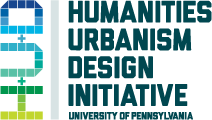Spring 2015
H+U+D CITY SEMINAR
Description:
An exploration of the city’s built environment as expressed in literature and in executed urban planning projects. Students will survey developments in the city from the post Revolutionary period to the mid-twentieth century. Included are readings from Hugo, Balzac, and Vernon and others. Projects ranging from works by Napoleon III and Haussmann to Mitterrand and Sarkozy to be examined. Course includes field trip to Paris during Spring Break.
Instructors:
Eugenie Birch, City and Regional Planning, and Andrea Goulet, Romance Languages
Notes from the Seminar:
 Twelve SAS and Wharton undergraduates, enrolled in FREN 300/CPLN300, The Making of Modern Paris are spending their Spring vacation in Paris where they are exploring the city, noting the sites portrayed in the 19th and 20th century fiction they have been reading while tracking the historical development and city planning efforts in the City of Lights. Their course, taught by Andrea Goulet, Associate Professor of French, Department of Romance Languages,, School of Arts and Sciences and Eugenie Birch, Nussdorf Professor of Urban Research, Department of City and Regional Planning, School of Design, assisted by Simon Mosbah, PhD candidate in City and Regional Planning and native of Paris, is funded by Penn’s Humanities, Design and Urbanism (H+U+D) project, funded by the Mellon Foundation to foster the integration of the Humanities and the Design professions around topics of urbanism. The program is sponsoring two international city seminars, this one on Paris and the other focused on Rio de Janiero, is taught by Daniel Barber, Assistant Professor of Architecture and John Tresch, Associate Professor, Department of History and Sociology of Science. In both instances, these courses represent the first time each team has taught together.
Twelve SAS and Wharton undergraduates, enrolled in FREN 300/CPLN300, The Making of Modern Paris are spending their Spring vacation in Paris where they are exploring the city, noting the sites portrayed in the 19th and 20th century fiction they have been reading while tracking the historical development and city planning efforts in the City of Lights. Their course, taught by Andrea Goulet, Associate Professor of French, Department of Romance Languages,, School of Arts and Sciences and Eugenie Birch, Nussdorf Professor of Urban Research, Department of City and Regional Planning, School of Design, assisted by Simon Mosbah, PhD candidate in City and Regional Planning and native of Paris, is funded by Penn’s Humanities, Design and Urbanism (H+U+D) project, funded by the Mellon Foundation to foster the integration of the Humanities and the Design professions around topics of urbanism. The program is sponsoring two international city seminars, this one on Paris and the other focused on Rio de Janiero, is taught by Daniel Barber, Assistant Professor of Architecture and John Tresch, Associate Professor, Department of History and Sociology of Science. In both instances, these courses represent the first time each team has taught together.
 In the French/City Planning course field trip, students are engaging in extensive walking tours of old and new Paris and visiting important exhibits – they caught one on Viollet-le-Duc (the restorer of Notre Dame and many other Parisian sites) and another on utopian visions of Paris that closed the day after their arrival. They crawled through the city’s underground limestone quarries and moved quickly through its famous sewers. They have traveled by Metro. streetcar and bus to the Bibliothèque nationale and new development on city’s outskirts and sat in boxes at the Opera Garnier. They have visited the Carnavalet (Museum of the City of Paris) and the Louvre. They have sampled crepes and falafel and are negotiating the local boulangeries for breakfast. They have walked the routes of Quasimodo and Esmeralda (from Victor Hugo’s Notre Dame of Paris) and visited Printemps and Galeries Lafayette to get a taste of the department store featured Emile Zola’s Ladies Paradise – novels they read in class before the trip. They are working in teams of two spending a full day, studying a site of their choice to understand both its physical design and expression in the arts. Student participants are: Daniella Castillo, Danielle Cerepnalkovic, Fangyu Chen, Andrea Davidson, Matthew Degagne, Shuhao Fan, Manuela Gonzalez, Kristen Kelly, Maria Manghi, Ethan Skaggs, Ciara Stein, and James Steitle.
In the French/City Planning course field trip, students are engaging in extensive walking tours of old and new Paris and visiting important exhibits – they caught one on Viollet-le-Duc (the restorer of Notre Dame and many other Parisian sites) and another on utopian visions of Paris that closed the day after their arrival. They crawled through the city’s underground limestone quarries and moved quickly through its famous sewers. They have traveled by Metro. streetcar and bus to the Bibliothèque nationale and new development on city’s outskirts and sat in boxes at the Opera Garnier. They have visited the Carnavalet (Museum of the City of Paris) and the Louvre. They have sampled crepes and falafel and are negotiating the local boulangeries for breakfast. They have walked the routes of Quasimodo and Esmeralda (from Victor Hugo’s Notre Dame of Paris) and visited Printemps and Galeries Lafayette to get a taste of the department store featured Emile Zola’s Ladies Paradise – novels they read in class before the trip. They are working in teams of two spending a full day, studying a site of their choice to understand both its physical design and expression in the arts. Student participants are: Daniella Castillo, Danielle Cerepnalkovic, Fangyu Chen, Andrea Davidson, Matthew Degagne, Shuhao Fan, Manuela Gonzalez, Kristen Kelly, Maria Manghi, Ethan Skaggs, Ciara Stein, and James Steitle.
See student pictures below:









